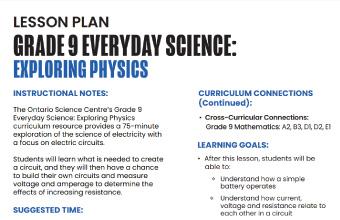Exploring Physics
Curriculum Connections
Strand A : STEM Skills, Careers, and Connections
| A1.2 | apply a scientific experimentation process and associated skills to conduct investigations, making connections between their observations and findings and the scientific concepts they are learning |
|---|---|
| A1.3 | apply an engineering design process and associated skills to design, build, and test devices, models, structures, and/or systems |
| A1.5 | apply their knowledge and understanding of safe practices and procedures, including the Workplace Hazardous Materials Information System (WHMIS), while planning and carrying out hands-on investigations |
| A2.1 | design an experiment or a prototype to explore a problem relevant to a STEM-related occupation, such as a skilled trade, using findings from research |
| A2.2 | describe how scientific innovations and emerging technologies, including artificial intelligence systems, impact society and careers |
| A2.5 | analyse contributions to science by people from various communities, including communities in Canada |
Strand C : Chemistry
| C2.2 | research the role of experimental evidence in the development of various atomic models, and compare and contrast different models of the atom |
|---|---|
| C2.3 | identify the location, relative mass, and charge of subatomic particles within an atom, using the Bohr-Rutherford model |
| C2.4 | explain the relationship between the position of an element in the periodic table and the structure of its atoms, using models |
Strand D : Physics
| D1.3 | develop a plan of action to address a local or global electrical energy production or consumption issue, including strategies for energy conservation |
|---|---|
| D2.1 | conduct investigations to explain the behaviour of electric charges in static and current electricity, and to relate the observed behaviour to the properties of subatomic particles and atomic structure |
| D2.2 | determine the conductivity of various materials by investigating their ability to hold or transfer electric charges |
| D2.3 | identify the components of a direct current (DC) circuit and explain their functions, and identify electrical quantities, their symbols, and their corresponding International System of Units (SI) units |
| D2.4 | investigate the relationships between electric current, potential difference, and resistance in electrical circuits, and develop a mathematical model to represent the relationships |
| D2.5 | apply a mathematical model to calculate electric current, potential difference, and resistance in real-world situations |
| D2.6 | construct series and parallel circuits to compare electric current, potential difference, and resistance in both types of circuits |
| D2.8 | determine the efficiency of various electrical devices that consume or produce electrical energy, and identify the energy transformations in each device |
